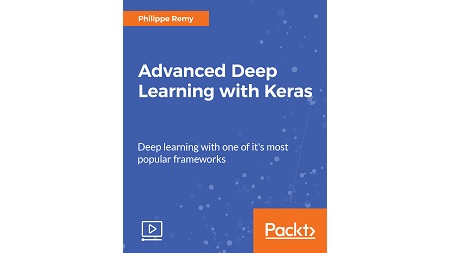
English | MP4 | AVC 1920×1080 | AAC 44KHz 2ch | 5h 11m | 1.01 GB
Explore Deep Learning with Keras
Keras is an open source neural network library written in Python. It is capable of running on top of MXNet, Deeplearning4j, Tensorflow, CNTK, or Theano. Designed to enable fast experimentation with deep neural networks, it focuses on being minimal, modular, and extensible.
This course provides a comprehensive introduction to deep learning. We start by presenting some famous success stories and a brief recap of the most common concepts found in machine learning. Then, we introduce neural networks and the optimization techniques to train them. We’ll show you how to get ready with Keras API to start training deep learning models, both on CPU and on GPU. Then, we present two types of neural architecture: convolutional and recurrent neural networks
First, we present a well-known use case of deep learning: recommender systems, where we try to predict the “rating” or “preference” that a user would give to an item. Then, we introduce an interesting subject called style transfer. Deep learning has this ability to transform images based on a set of inputs, so we’ll morph an image with a style image to combine them into a very realistic result. In the third section, we present techniques to train on very small datasets. This comprises transfer learning, data augmentation, and hyperparameter search, to avoid overfitting and to preserve the generalization property of the network.
Finally, we complete this course by what Yann LeCun, Director at Facebook, considered as the biggest breakthrough in Machine Learning of the last decade: Generative Adversarial Networks. These networks are amazingly good at capturing the underlying distribution of a set of images to generate new images.
What You Will Learn
- Understand the main concepts of machine learning and deep learning
- Install and use Python and Keras to build deep learning models
- Build, train, and run fully-connected, convolutional and recurrent neural networks
- Optimize deep neural networks through efficient hyper parameter searches
- See many real-world applications to identify which tasks can be leveraged with deep learning
- Work with any kind of data involving images, text, time series, sound and videos
- Use GPUs to leverage the training experience.
- Discover some advanced neural architectures such as generative adversarial networks
- Find out about a wide range of subjects from recommender systems to transfer learning
Table of Contents
01 The Course Overview
02 What is Deep Learning
03 Machine Learning Concepts
04 Foundations of Neural Networks
05 Optimization
06 Configuration of Keras
07 Presentation of Keras and Its API
08 Design and Train Deep Neural Networks
09 Regularization in Deep Learning
10 Introduction to Computer Vision
11 Convolutional Networks
12 CNN Architectures
13 Image Classification Example
14 Image Segmentation Example
15 Introduction to Recurrent Networks
16 Recurrent Neural Networks
17 тАЬOne to ManyтАЭ Architecture
18 тАЬMany to OneтАЭ Architecture
19 тАЬMany to ManyтАЭ Architecture
20 Embedding Layers
21 What are Recommender Systems
22 Content_Item Based Filtering
23 Collaborative Filtering
24 Hybrid System
25 Introduction to Neural Style Transfer
26 Single Style Transfer
27 Advanced Techniques
28 Style Transfer Explained
29 Data Augmentation
30 Transfer Learning
31 Hyper Parameter Search
32 Natural Language Processing
33 An Introduction to Generative Adversarial Networks (GAN)
34 Run Our First GAN
35 Deep Convolutional Generative Adversarial Networks (DCGAN)
36 Techniques to Improve GANs
Resolve the captcha to access the links!